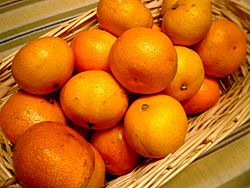Satsuma facts for kids
Quick facts for kids Citrus unshiu Marc. |
|
|---|---|
 |
|
| A mikan grove | |
| Scientific classification | |
| Kingdom: | |
| Division: | |
| Class: | |
| Subclass: | |
| Order: | |
| Family: | |
| Genus: | |
| Species: |
C. unshiu
|
The Satsuma (pronounced sat-soo-muh) is a special type of tangerine. It is known for its easy-to-peel, loose skin. This makes it a popular fruit, especially for snacks.
Satsumas get their name from the old Satsuma Province in Japan. This is where they are believed to have first become widely known. In the United Kingdom, Satsumas are often linked with the Christmas holiday season. People enjoy them as a festive treat.
Contents
What is a Satsuma?
A Satsuma is a type of citrus fruit. It belongs to the mandarin orange family. It is usually seedless and has a sweet, juicy flesh. The skin is thin and peels off very easily. This makes it a great fruit for kids.
Where Do Satsumas Grow?
Satsumas grow best in warm climates. They need lots of sunshine and mild winters. They are grown in many parts of the world.
- Japan: This is where Satsumas first became popular. They are still a very important crop there.
- United States: Satsumas are grown in states like Florida, Alabama, Louisiana, and California.
- Other Countries: You can also find Satsuma groves in China, Korea, Spain, and Turkey.
How Are Satsumas Harvested?
Satsumas are usually picked by hand. This helps to prevent bruising the delicate fruit. They are harvested in the fall and winter months. This is why they are often seen during the holiday season.
The History of Satsuma Oranges
Satsumas have a long and interesting history. They are thought to have originated in East Asia. They have been grown in Japan for hundreds of years.
How Satsumas Came to the West
Satsumas were brought to the Western world in the late 1800s.
- United States: In 1876, a Japanese diplomat sent Satsuma trees to the United States. They were planted in Florida.
- Gulf Coast: The trees also did very well along the Gulf Coast, especially in Alabama and Louisiana. This area has a climate similar to parts of Japan.
Why Are They Called Satsumas?
The name "Satsuma" comes from the former Satsuma Province in Japan. This area is now part of Kagoshima Prefecture. The first trees sent to the U.S. came from this region.
Nutritional Benefits of Satsumas
Satsumas are not just tasty; they are also very good for you!
- Vitamin C: They are packed with Vitamin C. This vitamin helps your body fight off colds and keeps your immune system strong.
- Fiber: Satsumas also contain dietary fiber. Fiber is important for healthy digestion.
- Antioxidants: They have special compounds called antioxidants. These help protect your body's cells from damage.
How to Enjoy Satsumas
Satsumas are great to eat fresh. You can also use them in many recipes.
- Snacks: They are perfect for a quick, healthy snack.
- Salads: Add segments to fruit or green salads for a sweet and tangy flavor.
- Desserts: Use them in tarts, cakes, or even just as a simple topping for yogurt.
- Juice: You can also squeeze them for fresh, delicious juice.
Life Cycle of a Satsuma Tree
Satsuma trees are evergreen. This means they keep their leaves all year round. They can grow to be quite large, sometimes up to 20 feet tall.
How Satsuma Trees Reproduce
Satsuma trees usually reproduce through grafting. This is a method where a part of one plant is joined to another. This helps to make sure the new tree has the same good qualities as the parent tree.
- Flowers: In the spring, Satsuma trees produce small, white, fragrant flowers.
- Fruit Development: After the flowers are pollinated, tiny green fruits begin to form.
- Ripening: Over the summer and fall, these fruits grow larger and change color from green to orange. They become sweet and juicy when they are ripe.
See also
 In Spanish: Satsuma para niños
In Spanish: Satsuma para niños



